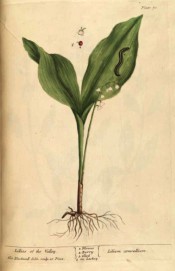Convallaria majalis L.
Hardy, rhizomatous perennial, the lance-shaped to elliptic basal leaves and arching racemes of pendent, bell-shaped, strongly scented white flowers produced in spring. To 25cm. [RHSE, Hortus].
Horticultural & Botanical History
Both double-flowered and pink forms were available to Victorian gardeners. The roots, known in the trade as ‘pips’, were once sold by apothecaries to treat heart ailments. ‘It may not be generally known that [Lily of the valley] may be successfully cultivated in pots for forcing year after year’. [Gard. Chron. 1854]. Ancient garden plant. ‘Lillies of the Valley. Lilium convallium. It grows to be about 8 or 10 inches high; the leaves are a grass green, and the flowers white. It grows in the vallies, but chiefly in gardens, and flowers in May and June. Lillies of the Valley are of great service in all disorders of the head and nerves; as apoplexy, epilepsy, palsy, convulsions, vertigo. They are much used in Errhines and cephalic stuff. A large quantity of them are put in the Aqua Paeoniae C. and spirit Lavandulae C. and the Aq. Antileptica.’ [Blackwell pl.70/1737].
History at Camden Park
Listed in all published catalogues [B.71/1843].
Notes
Published Jan 03, 2010 - 05:19 PM | Last updated Jul 16, 2010 - 03:22 PM
| Family | Convallariaceae |
|---|---|
| Category | |
| Region of origin | North temperate regions |
| Synonyms | |
| Common Name | Lily-of-the-Valley, May lily |
| Name in the Camden Park Record |
Convallaria majalis |
| Confidence level | high |
